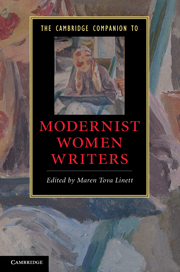Book contents
- Frontmatter
- Modernist women’s literature: an introduction
- 1 Transforming the novel
- 2 Modernist women poets and the problem of form
- 3 Women’s modernism and performance
- 4 Magazines, presses, and salons in women’s modernism
- 5 Gender in women’s modernism
- 6 Black women’s modernist literature
- 7 Race and ethnicity in white women’s modernist literature
- 8 Geomodernism, postcoloniality, and women’s writing
- 9 Women modernists and visual culture
- 10 Modernism and trauma
- 11 Political activism and women’s modernism
- 12 Religion and the occult in women’s modernism
- Guide to further reading
- Index
4 - Magazines, presses, and salons in women’s modernism
Published online by Cambridge University Press: 28 November 2010
- Frontmatter
- Modernist women’s literature: an introduction
- 1 Transforming the novel
- 2 Modernist women poets and the problem of form
- 3 Women’s modernism and performance
- 4 Magazines, presses, and salons in women’s modernism
- 5 Gender in women’s modernism
- 6 Black women’s modernist literature
- 7 Race and ethnicity in white women’s modernist literature
- 8 Geomodernism, postcoloniality, and women’s writing
- 9 Women modernists and visual culture
- 10 Modernism and trauma
- 11 Political activism and women’s modernism
- 12 Religion and the occult in women’s modernism
- Guide to further reading
- Index
Summary
Women's modernism as reflected in the operations of magazines, presses, and salons is a topic at once expansive and specific. Certainly it is open to a variety of approaches. To borrow playfully from Virginia Woolf, the topic may indicate “women and what they are like”; or it might mean “women and the fiction that they write” as produced by certain publishing concerns for particular readers; or it might mean discussions in social salons by or about women and their writings; again, it might signify an interlocking pattern of women, the salons that they convene, and the publications they run or in which they appear. This final approach - finding all of these aspects “inextricably mixed together” - means that a single chapter about women, modernism, presses, and salons “should never be able to come to a conclusion” due to the unavoidable complexity in any matter that involves sex. It is now a truism of modernist scholarship that small presses and “little” magazines fostered the aesthetic innovations that later became canonized as literary modernism. Women's work in such venues necessarily contributed to the development of modernist aesthetics, despite social attitudes of the time that tended to ignore or belittle aspects of the feminine. Experimental writings by Gertrude Stein, Dorothy Richardson, H. D., Marianne Moore, Mina Loy, Virginia Woolf, Djuna Barnes, Zora Neale Hurston, and other women provoked and responded to fiction and poetry by Ford Madox Ford, James Joyce, Ezra Pound, T. S. Eliot, Langston Hughes, Jean Toomer, D. H. Lawrence, and other men.
- Type
- Chapter
- Information
- The Cambridge Companion to Modernist Women Writers , pp. 62 - 77Publisher: Cambridge University PressPrint publication year: 2010
- 1
- Cited by



